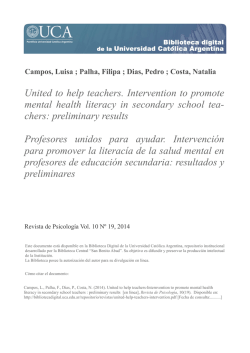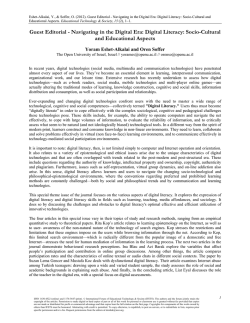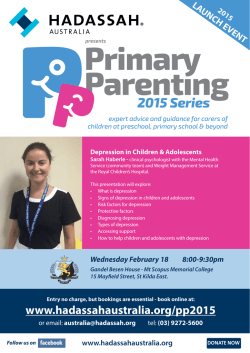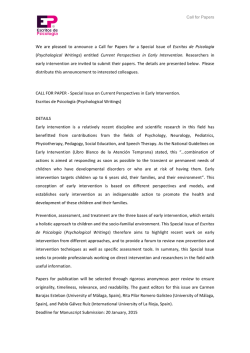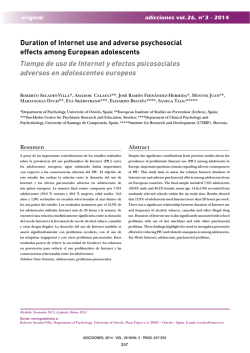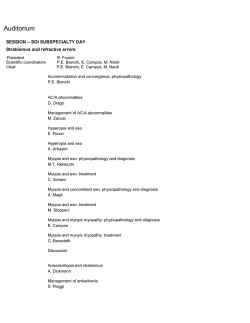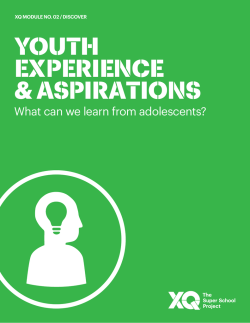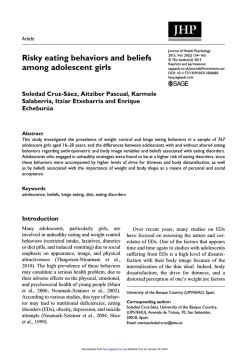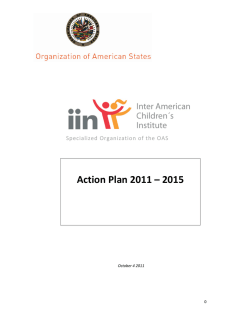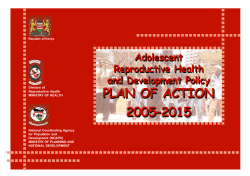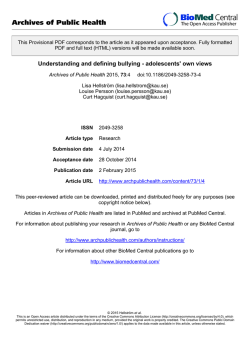
Finding space to mental health – promoting - Biblioteca Digital
Campos, Luisa ; Dias, Pedro ; Palha, Filipa ; Duarte, Ana ; Veiga, Elisa Finding space to mental health – promoting mental health in adolescents (12 to 14 year olds): preliminary results of the intervention's effectiveness Abrir espacio para la salud mental – promoción de la salud mental en adolescentes (12-14 años): los resultados preliminares de la eficacia de la intervención Revista de Psicología Vol. 10 Nº 19, 2014 Este documento está disponible en la Biblioteca Digital de la Universidad Católica Argentina, repositorio institucional desarrollado por la Biblioteca Central “San Benito Abad”. Su objetivo es difundir y preservar la producción intelectual de la Institución. La Biblioteca posee la autorización del autor para su divulgación en línea. Cómo citar el documento: Campos, L., Dias, P., Palha, F., Duarte, A., Veiga, E. (2014). Finding space to mental health – promoting mental health in adolesents (12 to 14 year olds) : preliminary results of the intervention's effectiveness [en línea], Revista de Psicología, 10(19). Disponible en: http://bibliotecadigital.uca.edu.ar/repositorio/revistas/finding-space-mental-health.pdf [Fecha de consulta:..........] ISSN 1669-2438 Revista de Psicología. Año 2014. Vol. 10, Nº 19, pp. 107-116 Finding Space to Mental Health – Promoting mental health in adolescents (12- to 14 year olds): Preliminary results of the intervention’s effectiveness Abrir Espacio para la Salud Mental – Promoción de la salud mental en adolescentes (12-14 años): Los resultados preliminares de la eficacia de la intervención Luísa Campos* Pedro Dias* Filipa Palha* Ana Duarte** Elisa Veiga* 1 Resumen La salud mental y el bienestar son fundamentales para nuestra capacidad colectiva y individual como seres humanos de pensar, de exteriorizar los sentimientos, de establecer y mantener relaciones, para estudiar, para perseguir las actividades de ocio, para tomar decisiones diarias y para disfrutar de una vida plena. Una adolescencia saludable es un prerrequisito para una vida adulta saludable. Sin embargo, la realidad actual presenta un panorama preocupante. La formación del capital mental individual y colectivo - especialmente en las primeras etapas de la vida - está siendo retenida por una serie de riesgos evitables para la salud mental (World Health Organization [WHO], 2013). Los adolescentes del sur de Europa (región que ha sido más severamente afectada por la crisis financiera; e.g., Portugal) son señalados como un grupo extremadamente vulne- rable, ya que su salud mental fácilmente podría ser influenciada por las dificultades económicas de sus padres y la escasez de solidaridad social (European Parliament, 2012). La promoción de la salud mental de los adolescentes es considerada como una preocupación fundamental (WHO, 2005a, 2013). En este ámbito, las intervenciones centradas en la promoción de la literacía de la salud mental han revelado importantes ventajas en la prevención, reconocimiento, intervención precoz y la reducción del estigma (Pinfold, Stuart, Thornicroft & Arboleda-Florez, 2005; Pinfold, Toulmin, Thornicroft, Huxley, Farmer & Graham, 2003; Schulze, Richter-Werling, Matschinger & Angermeyer, 2003; Stuart, 2006). En consonancia con los marcos de promoción de la salud mentales propuestos por la Organización Mundial de la Salud (2005a), tenemos que involucrar a jóvenes en los ambientes donde interactúan * Researchers at the Centre for Studies in Human Development and Professors at the Faculty of Education and Psychology, Catholic University of Portugal. ** Researcher at the Centre for Studies in Human Development. Correo electrónico: [email protected] Fecha de recepción: 25 de septiembre de 2013 - Fecha aceptación: 28 de marzo de 2014 108 Finding Space to Mental Health – Promoting mental health in adolescents (Burns, 2011). Las escuelas son implícitamente uno de los locales más importantes para la promoción de la salud mental de los adolescentes (Barry, Clarke, Jenkins & Patel, 2013; WHO, 2001). El proyecto “Abrir Espacio para la Salud Mental – Promoción de la salud mental en adolescentes (12-14 años)” tiene como objetivo incrementar literacía de la salud mental en los jóvenes. En el primer año se ha desarrollado un instrumento de evaluación - Mental Health Literacy questionnaire (MHLq) - y la intervención para la promoción de la salud mental. La intervención consiste en 2 sesiones, 90 minutos cada una, implementadas con intervalo de una semana. Siguen una metodología interactiva, utilizando dinámicas de grupo, videos, música y discusión. El estudio de la eficacia de la intervención se lleva a cabo mediante un análisis pre y pos-test con el MHLq, utilizando un grupo experimental y un grupo de control. Este artículo presenta los resultados preliminares de la eficacia de la intervención de promoción de la salud mental en una muestra de 100 adolescentes portugueses (12-14 años). El pos-test mostró un incremento de los niveles de conocimientos de salud mental y estrategias de autoayuda. Los resultados sugieren que la intervención desarrollada parece ser adecuada al objetivo propuesto y refuerzan la creencia de que intervenciones escolares, sistemáticas y sostenibles, para la promoción de la salud mental con jóvenes, es un enfoque prometedor para la promoción de la literacía de la salud mental (Schulze et al., 2003; Rickwood et al., 2005; Corrigan et al., 2007; WHO, 2010). Palabras clave: promoción de la salud mental, jóvenes, literacía de la salud mental, estigma, escuelas, eficacia de la intervención. Abstract Mental health and well-being are fundamental to our collective and individual ability as humans to think, to feel emotions, to form and maintain relationships, to study, to pursue leisure interests, to make day-to-day decisions and to enjoy a fulfilling life. A healthy adolescence is a prerequisite for a healthy adulthood. However, the current reality presents a concerning picture. The formation of individual and collective mental capital – especially in the earlier stages of life – is being held back by a range of avoidable risks to mental health (World Health Organization [WHO], 2013). Adolescents from Southern Europe (region that has been more severely hit by the financial crisis; e.g., Portugal) are pointed out as an extremely vulnerable group, as their mental health might easily be influenced by their parents’ economic difficulties and by the lack of social solidarity (European Parliament, 2012). Adolescents’ mental health promotion is regarded as a vital concern (WHO, 2005a, 2013). Interventions focused on mental health literacy promotion have revealed important advantages in preventing, recognising, early intervening and reducing stigma (Pinfold, Stuart, Thornicroft & Arboleda-Florez, 2005; Pinfold, Toulmin, Thornicroft, Huxley, Farmer & Graham, 2003; Schulze, Richter-Werling, Matschinger & Angermeyer, 2003; Stuart, 2006). Consistent with mental health promotion frameworks proffered by the World Health Organization (2005a), we must engage with young people in environments where they interact (Burns, 2011). Schools are implicitly one of the most important settings for promoting the mental health of adolescents (Barry, Clarke, Jenkins & Patel, 2013; WHO, 2001). The “Finding Space to Mental Health: Promoting mental health in adolescents (12- to 14 year olds)” project aims at increasing young people’s mental health literacy. During the first year, an assessment instrument – Mental Health Literacy questionnaire (MHLq) - and a two-day intervention were developed. The intervention is composed by 2 sessions at one-week intervals, lasting 90 minutes each. Sessions follow an interactive methodology, using group dynamics, music and videos and group discussions regarding participants’ emotional well-being. The study of the Revista de Psicología. Año 2014. Vol. 10. Nº 19, pp. 107-116 Finding Space to Mental Health – Promoting mental health in adolescents intervention’s effectiveness is conducted through a pretest-postest design using the MHLq in both an experimental group and a control group. This article presents the preliminary results regarding the effectiveness of the intervention aimed at enhancing mental health literacy in a sample of 100 Portuguese adolescents (12- to 14-year-olds). The postest showed students’ increased levels of knowledge and self-help strategies. These results suggest that the intervention developed appears to be adequate to the proposed goal, and they strengthen the belief that targeting young people in systematic and sustainable school-based intervention is a promising approach for the promotion of mental health literacy (Rickwood, Deane, Wilson & Ciarrichi, 2005; Schulze et al., 2003; WHO, 2010). Keywords: mental health promotion, young people, mental health literacy, stigma, schools, effectiveness of the intervention. In recent years, the promotion of mental health has become a main health concern (WHO, 2005b) based on the recognition of the burden associated with mental health problems (WHO, 2005c). Young people are an important target group for mental health promotion (Rickwood et al., 2005; WHO, 2010) and stigma reduction (Hinshaw, 2005) for several reasons: 1) natural risk of developing a mental disorder (Jané-Llopis & Braddick, 2008; Patel, Flisher, Hetrick & McGorry, 2007); 2) most of the mental health problems are developed in the youth (Kelly, Jorm & Wright, 2007; 109 Patel et al., 2007); 3) stigma associated with mental health problems seems to arise from the age of 5 (Aboud, 2003; Wahl, 2002); 4) adolescence is considered a stage where attitudes can be changed (Schulze et al., 2003; Wahl, 2002). Amongst the domains where action can been taken, two areas have been identified as priorities: individuals’ increase of mental health literacy – “knowledge and beliefs about mental disorders which aid their recognition, management or prevention” (Jorm, Korten, Jacomb, Christensen, Rodgers & Pollitt, 1997, p. 182) -, and reduction of the stigma associated with mental health problems (European Commission & Portuguese Ministry of Health, 2010). In this context, school-based interventions have become an essential strategy for promoting mental health literacy in adolescents (Pinfold et al., 2005). Worldwide, initiatives to promote mental health literacy and to combat mental illness stigma in the school setting have been developed (MINDSET, 2002; Stuart, 2006; Tacker & Dobie, 2008; Wyn, Cahill, Holdsworth, Rowling & Carson, 2000). In Portugal little investment has been made regarding this issue, and the Mental Health National Plan reports a limited response to vulnerable groups’ needs (Comissão Nacional para a Reestruturação dos Serviços de Saúde Mental, 2007). In fact, it was only in 2007 that the first national anti-stigma campaign was Revista de Psicología. Año 2014. Vol. 10. Nº 19, pp. 107-116 110 Finding Space to Mental Health – Promoting mental health in adolescents launched by ENCONTRAR+SE1, under the umbrella of a movement aimed at combating stigma and discrimination of mental illness named ‘‘Movimento UPA— Unidos para Ajudar’’ (‘‘UPA - United to Help Movement’’). Ever since, other projects have been developed under the UPA movement, focusing on studying stigma related to mental illness, on improving awareness about mental health issues, and on combating stigma and discrimination in different population groups (Beldie et al., 2012), namely UPA Makes the Difference, and P’UPA United to Help Teachers (Campos, 2013; Campos, Palha, Dias, Sousa Lima, Veiga, Costa & Duarte, 2012). Recently, another school-based initiative was implemented in Portugal, aiming to promote mental health in young people “Mental health education and awareness: An intervention programme based on adolescents and young people’s school”2. The project “Finding Space to Mental Health - Promoting mental health in 1. Association for the promotion of mental health (http://www.encontrarse.pt/) 2. The main objective of this project is the creation of a website in order to increase the levels of mental health literacy, for adolescents and young people between 15 and 22 years-olds attending schools. The intervention aims to increase recognition of mental disorders, help-seeking behaviours associated, and combating stigma and discrimination about mental illness, namely related to depression, substance use, anxiety, eating disorders and psychosis (Loureiro et al., 2011) adolescents (12-14 year-olds): Development and evaluation of an intervention” (PTDC/PSI-PCL/112526/2009), is developed by the Faculty of Education and Psychology, Catholic University of Portugal, and funded by Science and Technology Foundation. The “Finding Space to Mental Health” is a 3-years project that aims to: 1) develop a rigorous assessment instrument capable of assessing knowledge about mental health in 12-14 year-olds students, and of being an outcome measure of the intervention; 2) develop an intervention intended to be effective in enhancing mental health literacy of 12-14 year-olds students, attending 7th, 8th and 9th grades, and; 3) implement and evaluate the intervention’s effectiveness. During the first year of the project a pilot study was carried out focusing on the development of an assessment instrument – Mental Health Literacy questionnaire (MHLq), and on a mental health promotion intervention. The pilot study occurred in two phases: 1) focus groups in order to develop the “Mental Health Literacy questionnaire” (MHLq) and; 2) the implementation of a pilot intervention with the purpose of studying its appropriateness and studying the MHLq’s psychometric properties (Campos, Dias & Palha, 2014). This article aims to discuss the preliminary results regarding the effectiveness of the intervention, in a sample of 100 Portuguese adolescents (12-14 yearolds). Revista de Psicología. Año 2014. Vol. 10. Nº 19, pp. 107-116 Finding Space to Mental Health – Promoting mental health in adolescents Method 111 Measures Sample Mental Health Literacy questionnaire (MHLq) The sample is composed of one hundred students from a total of 308 of the experimental group, aged between 12 to 14 year-olds (M = 13.02; SD = 0.78), 58.6% male and 41.4% were female. All students were Portuguese and from the North of the country. In what refers to contact with people with mental health problems, 36 (36.7%) students reported knowing someone presenting a mental health problem, 24 (24.5%) stated they did not know anyone with these problems, and 38 (38.8%) were not aware. Regarding the degree of proximity, 18 students (51.4%) mentioned the selected person to be a family member, 12 participants (34.3%) a friend, and 5 students (14.3%) indicated another person. Mental health problems identified by students in those people included, Schizophrenia (N = 5; 19.23%), Depression (N = 4; 15.38%), Autism (N = 4; 15.38%), Mental disability (N = 2; 7.69%), Alzheimer’s (N = 2; 7.69%), Amnesia (N = 1; 3.85%), Anxiety (N = 1; 3.85%), Cancer (N = 1; 3.85%), Down’s Syndrome (N = 1; 3.85%), Hallucinations (N = 1; 3.85%), and Parkinson’s (N = 1; 3.85%). Five students (19.23%) were unable to identify the mental health problem. The questionnaire comprises 1) a socialdemographic form, 2) a multiple-choice item, and 3) 33 items organized in a 5-point Likert scale (1 = strongly disagree to 5 = strongly agree), encompassing three sections: a) knowledge/stereotypes, b) first aid skills & help seeking, and c) self-help strategies (Campos & Dias, 2014). Mental health promotion intervention The intervention is composed of two sessions, lasting 90 minutes each, to be delivered with a one-week interval, conducted by a trained psychologist in collaboration with one master-level psychology student. Sessions follow an interactive methodology, using group dynamics, music, videos, adapted to the target-group (Campos et al, 2014). Procedures The study of the intervention’s effectiveness was conducted through a pretestposttest design using the MHLq previously described. All ethical procedures related to data collection authorization were taken. Revista de Psicología. Año 2014. Vol. 10. Nº 19, pp. 107-116 Finding Space to Mental Health – Promoting mental health in adolescents 112 Results Post-test Pre-test Overall, regarding three sections of the MHLq, participants demonstrated: a reasonable degree of knowledge (M = 3.88; SD = 0.38) and self-help strategies (M = 3.83; SD = 0.53), and high first aid & help seeking skills (M = 4.20; SD = 0.48). After participating on the intervention, at post intervention assessment students showed a significant increase in knowledge (pre: M = 3.88; SD = 0.38; post: M = 4.24; SD = 0.39; t (80) = -9.04; p < .001), and self-help strategies (pre: M = 3.83; SD = 0.53; post: M = 4.25; SD = 0.55; t (97) = -6.94; p < .001). In what concerns students’ first aid skills & help seeking, no significant differences were found (pre: M = 4.20; SD = 0.48; post: M = 4.24; SD = 0.42; t (94) = -0.94; p = 0.35) (see Table 1). Table 1. Differences between pre-test and post-test on MHLq sections Pre-test Post-test N Mean (SD) N Mean (SD) t Knowledge 81 3.88 (0.38) 81 4.24 (0.39) -9.04*** First aid skills & Help seeking 95 4.20 (0.48) 95 4.24 (0.42) -0.94 Self-help strategies 98 3.83 (0.53) 98 4.25 (0.55) -6.94*** ***p < .001 Discussion This work aims to present the preliminary results of “Finding Space to Mental Health”, a project with the main goal of promoting mental health in adolescents. This study used a sample of one hundred students (12-14 year-olds), with a prepost design aimed at assessing the effectiveness of the mental health promotion intervention that we developed. Post-intervention results showed a significant increase of knowledge and self-help strategies and no significant differences concerning first aid skills & help seeking. Although the literature suggests that consistent and effective changes in knowledge and attitudes towards mental health issues are considerably related Revista de Psicología. Año 2014. Vol. 10. Nº 19, pp. 107-116 Finding Space to Mental Health – Promoting mental health in adolescents to long-lasting intervention (Patton et al., 2000; Sartorius, 2006), preliminary results of the present study show the possibility to improve mental health literacy with shorter actions. These results highlight the relevance of guidelines suggested by literature regarding the development of interventions focused on promoting mental health, namely, conducting pilot studies with target groups through focus groups, in order to guarantee message (e.g. “wording”) and methodology accuracy (Campos et al., 2014; Evans, Mullet, Weist & Franz, 2005). During the first year of Finding Space of Mental Health project a pilot study was carried out, involving the development of focus groups with students aged between 12-14 years-old. In the pilot study, the mental health promotion intervention was developed with the students, according to their needs, their language, and their interests. In order to study its appropriateness, the pilot study ended with a “pilot mental health intervention”. Thus, the development of interventions that involve “listening” to the target groups, and where contents and strategies are rigorously constructed and tested with the targets group, seems to support the positive results obtained. Regarding the absence of significant differences regarding first aid & help seeking skills, it was an expected result. In fact, students in pre-intervention already showed relatively high levels in this dimension. 113 In conclusion, the preliminary results presented suggest that the intervention developed appears to be adequate to the proposed goal – mental health literacy promotion -, and reinforce the belief that targeting young people in systematic and sustainable school-based intervention is a promising approach for the promotion of mental health literacy (Rickwood et al., 2005; Schulze et al., 2003; WHO, 2010), since “the ideas taught to children during mental health awareness programmes in schools have the potential to infiltrate the community more broadly” (Burns & Rapee, 2006, p. 227). Acknowledgments The authors would like to thank the support from the schools where data collection took place – their boards, teachers and students. The study was awarded a grant from the Portuguese Science and Technology Foundation (PTDC/PSIPCL/112526/2009) and it is part of Finding Space to Mental Health project Promoting mental health in adolescents (12-14 years old): development and evaluation of an intervention – developed by the Faculty of Education and Psychology of the Catholic University of Portugal, in partnership with ENCONTRAR+SE – Association for the promotion of mental health. Revista de Psicología. Año 2014. Vol. 10. Nº 19, pp. 107-116 114 Finding Space to Mental Health – Promoting mental health in adolescents References Aboud, F. E. (2003). The formation of ingroup favoritism and out-group prejudice in young children: Are they distinct attitudes? Developmental Psychology, 39, 48–60. doi:[ 10.1037/00121649.39.1.48] Beldie, A. et al. (2012). Fighting stigma of mental illness in midsize European countries. Social Psychiatry and Psychiatric Epidemiology, 47 (1), 1-38. Barry, M., Clarke, A., Jenkins, R. & Patel, V. (2013). A systematic review of the effectiveness of mental health promotion interventions for young people in low and middle income countries. BMC Public Health, 13. doi:[10.1186/14712458-13-835] Burns, J. (2011). Enabling all young Australians to grow up safe, happy, healthy and resilient: a collaboration for young people, technology and wellbeing. Australasian Psychiatry, 19, Sup. 1. doi:[10. 3109/10398562.2011.583043] Burns, J. & Rapee, R. (2006). Adolescent mental health literacy. Young people’s knowledge of depression and help seeking. Journal of Adolescence, 29, 225–239. doi: [10.1016/j.adolescence.2005.05.004] Comissão Nacional para a Reestruturação dos Serviços de Saúde Mental (2007). Relatório – Proposta de plano de acção para a reestruturação dos serviços de saúde mental em Portugal 2007-2016. Retrieved from Portuguese Health Ministry website http://www.acs.minsaude.pt/ Campos, L. (2013). Commentary on the paper, ‘Evaluation of a campaign to improve awareness and attitudes of young people towards mental health issues’ (Livingston et al., 2012). Education and Health, 31 (1), 45-50. Campos, L. & Dias, P. (2014). Development and psychometric properties of a new questionnaire for assessing Mental Health Literacy in young people. Manuscript submitted for publication. Campos, L., Dias, P. & Palha, F. (2014). Finding Space to Mental Health - Promoting mental health in adolescents: Pilot study. Education and Health, 32 (1), 23-29. Campos, L., Palha, F., Dias, P., Sousa Lima, V., Veiga, E., Costa, N. & Duarte, A. (2012). Mental health awareness intervention in schools. Journal of Human Growth and Development, 22 (2), 259266. European Commission & Portuguese Ministry of Health (2010). Background document for the thematic conference - Promoting Social Inclusion and Combating Stigma for better Mental Health and Wellbeing. Retrieved from European Commission website http://ec.europa.eu/health/ mental_health/policy/index_en.htm European Parliament (2012). Mental health in times of economic crisis. Workshop conducted on European Parliament, Brussels, Belgium. Retrieved from European Parliament website http://www. europarl.europa.eu/ Evans, S. W., Mullet, E., Weist, M. D. & Franz, K. (2005). Feasibility of the MindMatters School Mental Health Promotion Program in American Schools. Journal of Youth and Adolescence, 34 (1), 51-54. doi:[ 10.1007/s10964-0051336-9] Hinshaw, S. P. (2005). The stigmatization of mental illness in children and parents: Developmental issues, family Revista de Psicología. Año 2014. Vol. 10. Nº 19, pp. 107-116 Finding Space to Mental Health – Promoting mental health in adolescents concerns, and research needs. Journal of Child Psychology and Psychiatry and Allied Disciplines, 46, 714–34. doi:[ 1111/j.1469-7610.2005.01456.x] Jané-Llopis, E. & Braddick, F. (Eds). (2008). Mental Health in Youth and Education. Consensus paper. Luxembourg: European Communities. Jorm, A., Korten, A., Jacomb, P., Christensen, H., Rodgers, B. & Pollit, P. (1997). “Mental health literacy”: a survey of the public’s ability to recognise mental disorders and their beliefs about the effectiveness of treatment. The Medical Journal of Australia, 166 (4), 182-186. Kelly, C., Jorm, A. & Wright, A. (2007). Improving mental health literacy as a strategy to facilitate early intervention for mental disorders. The Medical Journal of Australia, 187 (7), 26-29. Loureiro, L. et al. (2011). Mental Health Education and Sensibilization: A Schoolbased Intervention Program for Adolescents and Young. Retrieved from Escola Superior de Enfermagem de Coimbra website https://www.esenfc.pt/site/index. php?module=ui&target=outreachproject s&id_projecto=57&id_linha_investigaca o=1&tipo=UI&q=Educa%E7%E3o%20 sa%FAde%20mental MINDSET. Health in Mind. (2002). Retrieved from Les Jardines website http:// www.jardines.com/community/mindset/ education-and-prevention.html Patel, V., Flisher, A., Hetrick, S. & McGorry, P. (2007). Mental health of young people: A global public-health challenge. Lancet, 369, 1302–13. Patton, G., Glover, S., Bond, L., Butler, H., Godfrey, C., Di Pietro, G. & Bowes, G. (2000). The Gatehouse Project: A systematic approach to mental health pro- 115 motion in secondary schools. Australian and New Zealand Journal of Psychiatry, 34, 586-593. Pinfold, V., Stuart, H., Thornicroft, G. & Arboleda-Florez, J. (2005). Working with young people: the impact of mental health awareness programmes in schools in the UK and Canada. World Psychiatry, 4 (1), 48-52. Pinfold, V., Toulmin, H., Thornicroft, G., Huxley, P., Farmer, P. & Graham, T. (2003). Reducing psychiatric stigma and discrimination: Evaluation of educational interventions in UK secondary schools. British Journal of Psychiatry, 182 (4), 342–346. doi:[10.1192/bjp.02.375] Rickwood, D., Deane, F., Wilson, C. & Ciarrochi, J. (2005). Young people’s help seeking for mental health problems. Australian e-Journal for the Advancement of Mental Health, 3 (4), 1-34. Sartorius, N. (2006). Lessons learned from a 10-year programme against stigma and discrimination because of an illness. Psychology, Health and Medicine, 11 (3), 383-388. doi:[10.1080/ 13548500600595418] Schulze, B., Richter-Werling, M., Matschinger, H. & Angermeyer, M. C. (2003). Crazy? So what! Effects of a school project on students’ attitudes towards people with schizophrenia. Acta Psychiatrica Scandinavica, 107 (2), 142-150. Stuart, H. (2006). Reaching Out to a High School Youth: The Effectiveness of a Video-Based Antistigma Program. The Canadian Journal of Psychiatry, 51 (10), 647-653. Tacker, K. & Dobie, S. (2008). MasterMind: empower yourself with mental health: a program for adolescents. Journal of School Health, 78 (1), 54-57. Revista de Psicología. Año 2014. Vol. 10. Nº 19, pp. 107-116 116 Finding Space to Mental Health – Promoting mental health in adolescents Wahl, O. (2002). Children’s views of mental illness: a review of the literature. Psychiatric Rehabilitation Skills, 6, 134-158. doi: [10.1080/10973430208408430] World Health Organization (2001). The World Health Report. Mental health: New understanding, New hope. Retrieved from WHO website http://www. who.int/en/ World Health Organization (2005a). Promoting mental health: Concepts, emerging evidence, practice: report of the World Health Organization. Retrieved from WHO website http://www.who.int/en/ World Health Organization (2005b). Mental health: facing the challenges, building solutions: report from the WHO European Ministerial Conference. Retrieved from WHO website http://www.who.int/en/ World Health Organization (2005c). Mental Health Action Plan for Europe: Facing the Challenges, Building Solutions. Copenhagen: World Health Organization. World Health Organization (2010). Mental Health Promotion in Young People – an investment for the future. Retrieved from WHO website http://www.who.int/en/ World Health Organization (2013). Investing in mental health: Evidence for action. Retrieved from WHO website http:// www.who.int/en/ Wyn, J., Cahill, H., Holdsworth, R., Rowling, L. & Carson, S. (2000). MindMatters, a whole-school approach promoting mental health and wellbeing. Australian and New Zealand Journal of Psychiatry, 34, 594-601. Revista de Psicología. Año 2014. Vol. 10. Nº 19, pp. 107-116
© Copyright 2026
